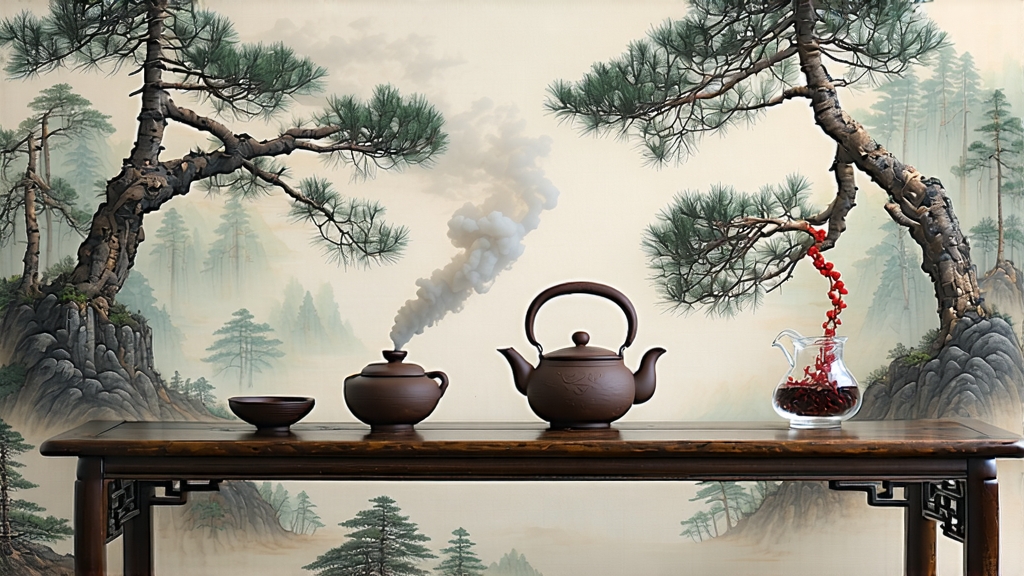
Tucked into the mist-wrapped mountains of southern China’s Guangxi Zhuang Autonomous Region, Liu Bao tea has spent four centuries quietly perfecting the art of transformation. To the uninitiated it is merely another dark brick, but to those who listen it recounts tales of horse caravans, river rafts, humid bamboo forests, and the patient alchemy of time. This essay invites the global tea lover to discover Liu Bao—the most maritime of China’s dark teas—tracing its journey from leaf to liquor and revealing why a single cup can taste like incense, dark honey, and the earth after summer rain.
-
Historical currents
Liu Bao takes its name from the old Liu Bao township of Wuzhou prefecture, once the last navigable port on the Xun River before the rapids that led to Guangdong. During the Qing dynasty, pressed baskets of this tea were lashed onto bamboo rafts and floated downstream to Guangzhou, then onward to Hong Kong and Southeast Asia. Laborers in Malaysian tin mines and rubber plantations came to rely on its warming, digestive qualities; dockside warehouses in Singapore unintentionally became aging cellars, where the tea absorbed sea breezes and tropical humidity. By the 1950s Liu Bao had become a currency of diaspora: a brick could pay a doctor, a tong of tea might seal a marriage. Today the Malaysian “return market” drives much of the vintage trade; connoisseurs in Kuala Lumpur will pay premiums for 1980s baskets that never left the port city, claiming the equatorial mold lent a velvet sweetness unobtainable in drier China. -
Terroir and leaf
The cultivar is almost always the large-leaf Camellia sinensis var. assamica that carpets the limestone foothills of Guangxi. Day-night temperature swings of 15 °C coax slow growth, concentrating polyphenols, while the karst geology infuses groundwater with minerals that later emerge as a savory, almost broth-like umami. Farmers pluck one bud with three or four leaves in late April, after the spring rains have fattened the shoots but before the monsoon arrives. The ideal leaf is described as “beef tongue”: broad, leathery, and slightly curled, capable of withstanding the intensive processing that follows. -
Crafting Liu Bao: six acts of transformation
a. Wilting under mountain shade – Fresh leaves are spread on bamboo racks for four to six hours, softening cell walls and initiating enzymatic oxidation.
b. Kill-green in iron woks – A five-minute tumble in 200 °C woks destroys leaf-green enzymes yet preserves deep-seated microbes vital to later aging.
c. Rolling by hand and foot – Workers wrap the hot leaves in cotton cloth and tread gently, bruising tissues without shredding them; this step pre-forms the ribbon-like twists that allow air to circulate inside the bamboo basket.
d. Wet piling – Unique among dark teas, Liu Bao undergoes a controlled 10–18 day post-fermentation. Leaves are piled 70 cm high, misted to 28 % moisture, and covered with jute sacks. Internal temperatures rise to 55 °C, activating a consortium of Aspergillus, Blastobotrys, and local yeasts that convert catechins into theaflavins and theabrownins, gifting the tea its russet color and betel-nut aroma.
e. Air-drying on bamboo poles – Instead of baking, the piles are broken up and sun-dried for three days, locking in microbial spores that will continue to work for decades.
f. Basket pressing and smoke curing – The semi-dry leaf is steamed, then tamped into cylindrical bamboo baskets lined with wild taro leaves. A final pass through a pine-wood smoke chamber for 30 minutes deposits a whisper of resin that deters insects and adds a camphor top note. -
The taxonomy of time
Liu Bao is classified not by harvest year alone but by “wei” (flavor epochs):- Qing wei (light epoch, 1–5 years): liquor the color of rosé, bright acidity, hints of raw cacao.
- Zhuan wei (turning epoch, 6–15 years): amber broth, emerging camphor and dried longan.
- Chen wei (mature epoch, 16–30 years): mahogany clarity, betel nut, wet earth, and a cooling menthol finish.
- Yao wei (medicinal epoch, 30+ years): near-black soup, silky